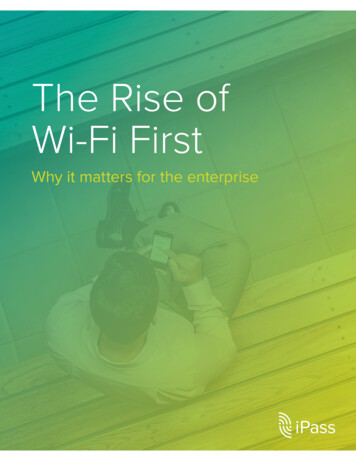
Transcription
The Rise ofWi-Fi FirstWhy it matters for the enterprise
With an ever-growing percentage of work communications happeningover mobile devices, it is now more crucial than ever for CIOs to find waysto maximize the quality of enterprise mobility while minimizing its cost.Unfortunately, finding the right mix is not easy.Traditionally, mobility strategies have relied on cellular connectivity, with alimited pool of providers from which to choose. In an environment of reducedchoice, quality improvement and cost reduction tended to get sacrificed.But after years of evolution and growth, Wi-Fi has made the leap to rivalcellular connectivity, becoming the dominant connection mode in the world.Wi-Fi now outpaces fourth-generation, long-term evolution (4G LTE) cellulartechnology, both in regions where mobile data infrastructure is highlydeveloped as well as in those where mobile data infrastructure is far lessubiquitous. Given its benefits and popularity, plus its potential for even betterservice delivery in the future, Wi-Fi should be at the centerpiece of anyCIO’s mobility strategy. This paper discusses the changes in the mobileecosystem that now make adopting a Wi-Fi-first mobility strategy a smartbet for forward-thinking CIOs.Given its benefits and popularity,plus its potential for even betterservice delivery in the future,Wi-Fi should be at the centerpieceof any CIO’s mobility strategyThe Rise of Wi-Fi First2
People prefer Wi-FiBy now, nine out of every ten people spend more than 19hours a day within range of a Wi-Fi connection.1 That’s aconnection they enjoy over others. Case in point: this yearmobile calling over Wi-Fi will surpass LTE calling in termsof the number of minutes of use.2Most everyday consumers adopt a ‘Wi-Fi first’ strategysimply, because they are technology agnostic and lovea good deal. With an eye to managing cellular dataconsumption, many smartphone users already chooseWi-Fi, not cellular, when given the option. That is becauseusing Wi-Fi does not eat into capped, monthly data allowances. Using Wi-Fi therefore offsets the cost of cellulardata plans, without leaving consumers vulnerable to dataoverages and roaming fees. Not only do Europeans andAmericans in general love Wi-Fi, but so too do international travelers. According to the Wireless BroadbandAssociation, 70 percent of international travelers rely onWi-Fi to stay connected when abroad, instead of usingtraditional mobile services.3CIOs ignore this love affair with Wi-Fi at their peril. Whenit comes to engagement, mobile professionals act justlike consumers. Studies show that the better connectedconsumers are the more engaged they are with brands.Similarly, the better connected workers are the moreengaged they are with their companies. And low employeeengagement significantly undercuts worker productivity.Gallup estimates that each disengaged employee costs anorganization 3,400 for every 10,000 in annual salary.Add it up, and that is a loss of anywhere between 450billion and 550 billion annually in the U.S. alone.470%Nine out of every ten people spend over19 hours a day within range of a Wi-Fi connection.Meanwhile, the Economist Intelligence Unit found a“measurable link” between a mobile-first workplace andan increase in employee engagement. Specifically, thestudy found that mobile-first “pioneers” saw a 16 percentjump in productivity, as well as significant increases increativity (18 percent), satisfaction (23 percent) and loyalty(21 percent), when compared to companies that did littleto support mobile technology.In sum, those figures represent an additional 6.4 hoursper week in a 40-hour work week, or an extra 41 days oreight weeks that every employee can devote to gettingmore done.To accrue those benefits, organizations will increasinglyhave to rely on Wi-Fi connectivity. Fortunately, manyhave already, as notes Ken Dulaney, vice president anddistinguished analyst at Gartner: “Ethernet cabling hasbeen the mainstay of the business workspace connectivitysince the beginning of networking. However, as smartphones, laptops, tablets and other consumer devices havemultiplied, the consumer space has largely converted to awireless-first world.”570 percent of internationaltravelers rely on Wi-Fi to stayconnected when abroad,instead of using traditionalmobile services.3The Rise of Wi-Fi First3
A growing trend in and outside of the enterpriseBy 2018, 40 percent of enterprises will specify Wi-Fi as thedefault connection for even non-mobile devices, such asdesktops, desk phones, projectors and conference rooms,predicts Gartner.6 The reason for this is that “additions,moves and changes are costly inconveniences that wastetime for enterprise IT organizations,” says Dulaney. “Amove can sometimes involve cabling changes that cancost as much as 1,000 to route and configure a connectorto the right place.” On the other hand, Wi-Fi connectivitycuts down costs and allows IT to regain time. “With Wi-Fiprinters, desktops and other devices, all that is required isa cable to the power source, leaving workers free to movethemselves making reconfigurations of offices easier.” Infact, Dulaney is predicting an enterprise IT environment,where Wi-Fi is the norm and wired is the exception.7Will Wi-Fi continue to deliver these remarkablebenefits into the future? It would appear so; as The Economist declares, “‘Wi-Fi first technology’ will be greatfor consumers, disruptive for mobile firms.”8 Moreover,research shows that in 2017 a significant majority of datatraffic will go over Wi-Fi networks.9Further evidence of the strength of Wi-Fi lies in the factthat Wi-Fi is being integrated into the service offerings ofMobile Network Operators and Mobile Virtual NetworkOperators, a relatively new breed of operators. In 2015, forinstance, Google partnered with major carriers Sprint andT-Mobile to launch Project Fi, a mobile virtual networkoffering that gives its subscribers access to the best available connection, whether that be on Wi-Fi or 4G LTE.Not only are innovative MVNOs, such as Republic Wireless,Scratch Wireless, Google’s Project Fi and FreedomPop,7xincreaseCisco is projecting a sevenfoldincrease in the number of publicWi-Fi hotspots around the worldover the next few years.11using Wi-Fi as their go-to connectivity technology.Huge Multi-service Operators, such as Comcast, AT&Tand Liberty Global, are also rolling out extensive Wi-Finetworks for their subscribers to roam on when outsideof the house.For many devices now, statistically speaking, Wi-Fi isalready the primary connectivity option, with cellularrelegated to a backup used to fill in the gaps of coverage.The same goes for countries such as the Netherlands,where close to three quarters of total connections go overWi-Fi networks. Adopting a Wi-Fi-first enterprise mobilitystrategy is becoming easier as a wireless ecosystem hasalready developed around the concept.Other signs of the ongoing strength of Wi-Fi as a connectivity mode include significant growth in the following: Community Wi-Fi is being popularized by companiessuch as Spain-based Fon, which have been pushingthe idea of a Wi-Fi router that broadcasts two ServiceSet Identifiers (SSIDs), one for the owner and thesecond for the public. The Fon network now has morethan 20 million hotspots. Municipal Wi-Fi deployments are making headlinesas city governments seek to extend Wi-Fi to theircitizens. In 2016, New York City launched LinkNYC,which replaced payphones with 7,500 new kiosksoffering free Wi-Fi with speeds up to 100 times fasterthan LTE.10 Similar municipal Wi-Fi projects are beingdeployed in other major cities in Western Europe andthe U.S. Public Wi-Fi access points around the world increasedfrom 1.3 million in 2011 to 5.8 million in 2015. AndCisco is projecting a sevenfold increase in the numberof public Wi-Fi hotspots around the world over thenext few years, estimated to grow to 432 million by2020.11 Inflight Wi-Fi is now more popular than an inflightmeal, according to research by Lonely Planet.12 Theairline industry is responding to this rapid growth indemand for inflight connectivity by improving adoption across the board; 60 carriers now offer Wi-Fi.The Rise of Wi-Fi First4
And in the U.S., most carriers offer inflight Wi-Fiservice on most of their planes. Curated, amenity Wi-Fi is becoming widely accessiblearound the world. As the name implies, amenityWi-Fi is a shared, complimentary service intended forguests and customers of businesses and public spaces.Companies such as Devicescape implement a curation process, which ensures that the amenity Wi-Fihotspots users connect to is of the highest quality.Wi-Fi growth driversMobile data traffic over Wi-Fi continues to grow at unprecedented rates. The following are significant contributoryfactors:Wi-Fi callingWi-Fi calling is a service for Android and iOS smartphonesproviding the ability to make and receive phone calls overa Wi-Fi connection. When you place a Wi-Fi call, it’s pickedup by your current Wi-Fi network, instead of a nearby celltower. If you have the feature enabled on your phone, anycall you make should be routed through Wi-Fi automatically; there’s no special button to press or program to use.For millions of consumers, Wi-Fi calling is already a fixtureof their mobile experience and one of the key benefitsof services like Republic Wireless and Project Fi, whichallow consumers to switch seamlessly between cellularand Wi-Fi. The capability is especially handy in locationswhere a cellular connection is spotty, such as in rural areasand locations within buildings where a cellular signal doesnot reach.Wi-Fi calling capability is akin to the technology thatpowers applications such as Google Hangouts, FacebookMessenger, Skype and WhatsApp, all of which allow usersto text or make calls over the internet, but bypass traditional data plans. That being said, a key benefit of Wi-Ficalling is the ability to make calls over Wi-Fi withouthaving to open a separate app and manage a new set ofcontacts.Moreover, Wi-Fi calling can be cheaper than using cellularnetworks, especially for international travelers who can Cable Wi-Fi, from operators such as Time WarnerCable, Xfinity, Optimum, Bright House Networks andCox Communications, are giving internet customersaccess to a collective network of more than 500million hotspots in the U.S. Carrier Wi-Fi is expanding rapidly. This year alone,carriers are planning to increase Wi-Fi access pointsby 33 percent.13Video will generatemuch of the mobile trafficgrowth through 2020.make a free call over Wi-Fi back to their home countrywithout incurring roaming charges. Cisco predicts thatby 2020, Wi-Fi calling will make up more than half of alldata-based voice calling. For context: Verizon only startedletting its customers route calls over Wi-Fi in 2007. Noweach one of the major U.S. carriers allows some form ofWi-Fi calling.ContentAs smartphones and tablets become more powerful andpopular, consumers grow more accustomed to accessingrich, high-bandwidth multimedia content on their Wi-Fienabled devices. Demand for multimedia over Wi-Fiis being fueled by the continued development of morepowerful smartphones and tablets and a growing assortment of real-time applications that encourage usersto consume multimedia when connected to wirelessnetworks.Because this content has much higher bit rates thanothers, video will generate much of the mobile trafficgrowth through 2020.14 Mobile video represented morethan half of global mobile data traffic beginning in 2012,indicating that it is already affecting traffic today, not justin the future.The Rise of Wi-Fi First5
The Wi-Fi industry is working to make sure this growthin video does not compromise the user experience forconsumers accustomed to multimedia on wired devicesand cellular networks. Wi-Fi Alliance members are investigating a certification program that will continue toimprove the user experience for Wi-Fi-certified devicesthat are multimedia capable when connected to networksdeployed in public hotspots, enterprise environments andresidential homes.DevicesOnce laptops were the only Wi-Fi enabled devices on themarket. This year there are predicted to be more than 7billion Wi-Fi enabled devices in use in the world. Backin 2014, 57 percent of all consumer electronics sold globally already had the ability to connect to Wi-Fi. And atthe beginning of last year, the Wi-Fi Alliance launchedWi-Fi HaLow, a new standard integral to the viability of theInternet of Things and connected home devices.The effect of HaLow will be to extend Wi-Fi’s usefulness toa new set of devices with lower power requirements andless need for long-range connectivity. It will also free unlicensed spectrum for more powerful Wi-Fi enabled devices.Wi-Fi StandardsLaunched in 2012 by the Wi-Fi Alliance, Wi-Fi CertifiedPasspoint streamlines access to Wi-Fi hotspots by eliminating the need for end users to find and authenticatea network each time they connect to it. Innovations likePasspoint are producing a more seamless, cellular-likeexperience for end users who connect to Wi-Fi.Instead of searching for, choosing and requestingconnection to a given access point each time, Passpointautomates the process and still delivers the industrystandard in security.This year there arepredicted to be more than7 billion Wi-Fi enableddevices in use in the world.ConclusionWe are in the midst of a major realignment in the wireless market, whereby advances in quality and breadth ofcoverage make Wi-Fi a viable alternative to cellular. Moreover, Wi-Fi’s inherent cost and speed advantage to cellularmakes it a better option for consumers and businesses.Against this backdrop, it just makes sense to treat Wi-Fias the central connection option for enterprise mobilityplans, for example by mandating that devices shouldconnect to hotspots rather than cellular networks wherever possible.Focusing your mobility efforts on Wi-Fi is not hard. Sucha ‘Wi-Fi first’ approach would mean that mobile devices,whether personal or company-liable, would use Wi-Fi astheir primary network when connecting to the internetand only use cellular to fill in the gaps. In some respects,it’s inevitable.The logic of this approach is underscored not only by agrowing range of Wi-Fi options, from community tocarrier services, but also by ongoing industry moves toimprove calling, content delivery, device range and easeof connectivity.The Rise of Wi-Fi First6
1. ns/2. Cisco, February 7, 2017: Cisco Visual Networking Index: Global Mobile Data Traffic Forecast Update,2016–2021 White Paper. Available at e-white-paper-c11-520862.html#Trend 4 Tracking WiFi Growth.3. faces-challenges-reveals-trai-699274. Susan Sorenson and Keri Garman, Gallup Business Journal, June 11, 2013: How to Tackle U.S. Employees’Stagnating Engagement. Available at e-employeesstagnating-engagement.aspx.5. Gartner press release, December 8, 2014: Gartner Says By 2018, More Than 50 Percent of Users Will Usea Tablet or Smartphone First for All Online Activities. Available at http://www.gartner.com/newsroom/id/2939217.6. Ibid.7. Ibid.8. The Economist, June 18, 2015: Change is in the air. Available at ptive-mobile-firms-change.9. ewhite-paper-c11-520862.html10. Valentina Palladino, Arstechnica, August 12, 2016: Link NYC kiosks provide public Wi-Fi you’ll actually want touse. Available at /.11. Eli Richman, Fierce Wireless, June 7, 2016: Public Wi-Fi hotspots to grow to 432M globally by 2020,suggesting possible threat to carriers. Available at ing-possible-threat-to.12. Alex Butler, Lonely Planet, May 25, 2016: In-flight meals or internet? Survey says more than half of airlinepassengers prefer Wi-Fi. Available at nternetairline/#ixzz4ZiwJOk4u.13. http://www.scwsworld.com/ media/Resources-Files/AlcatelLucent capture the market momentumwith carrier wifi.pdf14. Mobile video will see a compound annual growth rate (CAGR) of 62% between 2015 and 2020, higher thanthe overall average traffic CAGR of 53%. Of the 30.6 exabytes per month crossing the mobile network by2020, 23.0 exabytes will be due to video. Cisco, February 3, 2016: Cisco Visual Networking Index: GlobalMobile Data Traffic Forecast Update, 2015–2020. Available at http://www.academia.edu/25269703/CiscoVisual Networking Index Global Mobile Data Traffic Forecast Update 2015 2020.About iPassiPass is a leading provider of globalmobile connectivity, offering simple,secure, always-on Wi-Fi access on anymobile device. Built on a software-asa-service (SaaS) platform, the iPasscloud-based service keeps its customersconnected by providing unlimited Wi-Ficonnectivity on unlimited devices. iPassis the world’s largest Wi-Fi network,with more than 60 million hotspots inmore than 120 countries, at airports,hotels, train stations, convention centers,outdoor venues, inflight, and more.iPass Corporate HeadquartersiPass is a registered trademark of iPassInc. Wi-Fi is a registered trademark ofthe Wi-Fi Alliance. All other trademarksare owned by their respective owners.phone: 1 650-232-4100fax: 1 650-232-41113800 Bridge ParkwayRedwood Shores, CA 94065www.ipass.comThe Rise of Wi-Fi First7
CIO's mobility strategy. This paper discusses the changes in the mobile ecosystem that now make adopting a Wi-Fi-first mobility strategy a smart bet for forward-thinking CIOs. Given its benefits and popularity, plus its potential for even better service delivery in the future, Wi-Fi should be at the centerpiece of any CIO's mobility strategy











